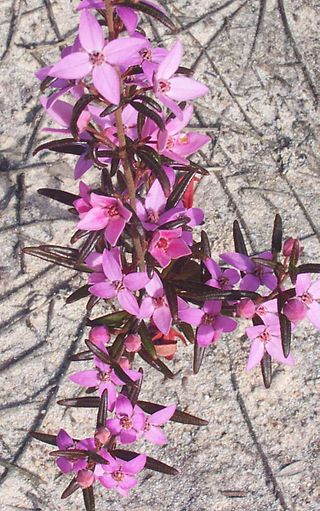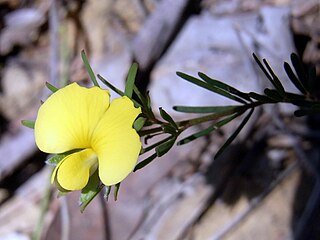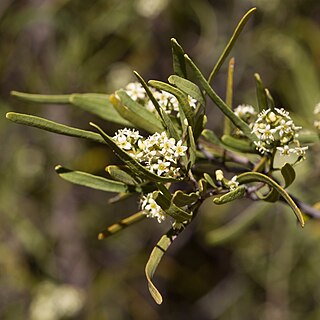
Pomaderris aspera, commonly known as hazel pomaderris, is a species of flowering plant in the family Rhamnaceae and is endemic to south-eastern Australia. It is a shrub or small tree with elliptic to lance-shaped or egg-shaped leaves and greenish-yellow flowers.

Boronia ledifolia, commonly known as the Sydney boronia, showy boronia or ledum boronia, is a plant in the citrus family Rutaceae and is endemic to south-eastern Australia. It is a shrub with simple or pinnate leaves which have a strong odour when crushed, and pale to bright pink flowers. Although difficult to propagate, this boronia is a popular garden plant.

Eucalyptus ligustrina, commonly known as the privet-leaved stringybark, is a species of shrub, mallee or small tree that is endemic to New South Wales. It has rough, stringy bark, lance-shaped to egg-shaped adult leaves, flower buds in groups of between seven and fifteen, white flowers and hemispherical or shortened spherical fruit.

Gompholobium glabratum, commonly known as dainty wedge-pea, is a species of flowering plant in the family Fabaceae and is endemic to south-eastern continental Australia. It is a low-lying or ascending shrub with pinnate leaves that have five to seven leaflets, and yellow and green or greyish flowers.

Persoonia trinervis is a species of flowering plant in the family Proteaceae and is endemic to the south-west of Western Australia. It is an erect, sometimes spreading shrub with densely hairy young branchlets, spatula-shaped or lance-shaped leaves with the narrower end towards the base, and densely hairy yellow flowers.

Zanthoxylum rhetsa, commonly known as Indian prickly ash, is a species of flowering plant in the family Rutaceae and occurs from India east to the Philippines and south to northern Australia. It is a deciduous shrub or tree with cone-shaped spines on the stems, pinnate leaves with between nine and twenty-three leaflets, panicles of white or yellowish, male and female flowers, followed by spherical red, brown or black follicles.

Isopogon villosus is a species of flowering plant in the family Proteaceae and is endemic to southwestern Western Australia. It is a tufted shrub with cylindrical leaves with twenty-five to thirty-two widely diverging lobes, and oval heads of cream-coloured to yellow flowers.
Tremandra diffusa is a species of flowering plant in the family Elaeocarpaceae. It is a small shrub with white flowers and green oval shaped leaves.

Leptospermum myrtifolium, commonly known as the myrtle tea-tree or grey tea-tree, is a species of shrub that is endemic to south eastern Australia. It has broad egg-shaped to elliptical leaves, white flowers usually borne singly on short side shoots, and fruit that remains on the plant until it dies.

Geijera linearifolia, commonly known as oilbush or sheepbush, is a species of shrub in the family Rutaceae and is endemic to southern Australia. It has simple linear to oblong leaves, much-branched cymes of greenish-white flowers, and fruit containing a shiny black seed.

Philotheca myoporoides subsp. myoporoides, commonly known as long-leaf wax flower, is a subspecies of flowering plant in the family Rutaceae and is endemic to south-eastern continental Australia. It is a shrub with oblong to elliptic or egg-shaped leaves and white or pink flowers arranged in groups of three to eight in leaf axils.

Pultenaea euchila, commonly known as orange pultenaea, is a species of flowering plant in the family Fabaceae and is endemic to eastern Australia. It is an erect shrub with glabrous foliage, narrow egg-shaped leaves with the narrower end towards the base, and orange-coloured flowers arranged singly or in small groups near the ends of branchlets.

Bossiaea lenticularis is a species of flowering plant in the family Fabaceae and is endemic to eastern New South Wales. It is a slender, spreading shrub with mostly circular leaves, and yellow and red flowers.

Podolobium scandens, commonly known as netted shaggy-pea, is a flowering plant in the family Fabaceae and is endemic to eastern Australia. It is a prostrate, small shrub with orange-yellow pea-like flowers and red markings.

Gompholobium virgatum, commonly known as leafy wedge pea, is a species of flowering plant in the family Fabaceae and is endemic to eastern Australia. It is an erect or sprawling shrub with trifoliate leaves, the leaflets narrow egg-shaped with the narrower end towards the base, and yellow and greenish, pea-like flowers.

Olearia cydoniifolia is a species of flowering plant in the family Asteraceae and is endemic to eastern Australia. It is a shrub with scattered elliptic leaves, and white and yellow, daisy-like inflorescences.

Epacris coriacea is a species of flowering plant in the heath family Ericaceae and is endemic to a eastern New South Wales. It is a slender, erect shrub with hairy branchlets, egg-shaped to more or less diamond-shaped leaves and tube-shaped, white or cream-coloured flowers.

Sprengelia monticola, commonly known as rock sprengelia, is a species of flowering plant of the family Ericaceae, and is endemic to the Blue Mountains in eastern New South Wales. It is an open or low-lying shrub with egg-shaped to lance-shaped leaves, and white flowers arranged singly in leaf axils.

Olearia quercifolia, commonly known as oak-leaved olearia, is a species of flowering plant in the family Asteraceae, and is endemic to the Blue Mountains in New South Wales. It is a shrub with elliptic to egg-shaped leaves with the narrower end towards the base, and white and yellow daisy flowers.

Leucopogon melaleucoides is a species of flowering plant in the heath family Ericaceae and is endemic to eastern Australia. It is an erect, densely branched shrub with lance-shaped or egg-shaped leaves, and white, tube-shaped flowers arranged in spikes in upper leaf axils.



















